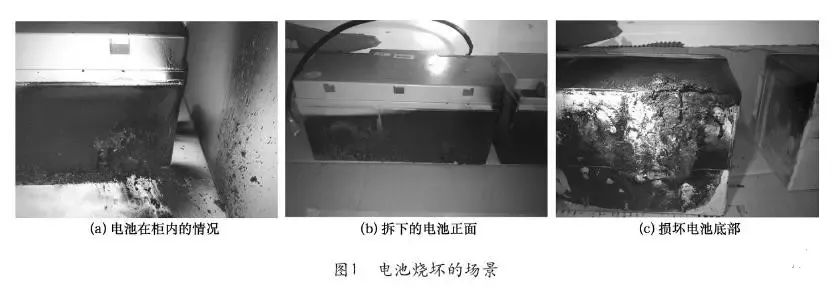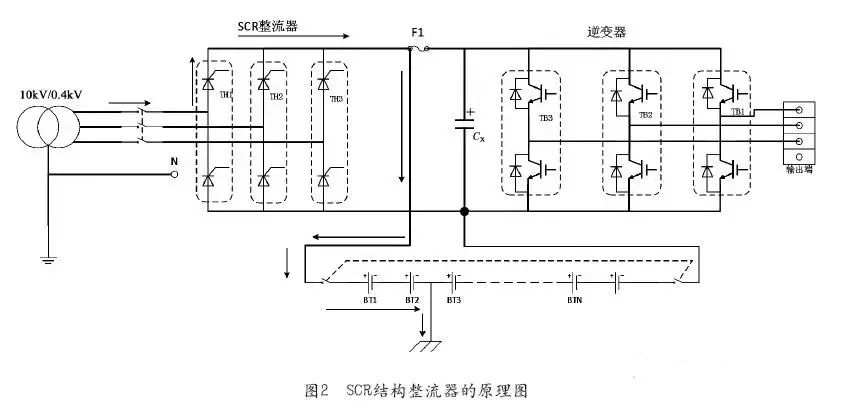1 Accident occurred
(1) Two 30kVAUPS of XX enterprise, the battery is 12V/65Ah, and one of the batteries caught fire and smoked. The smoke is very large, the entire distribution room is full of smoke, the electrical staff brought anti-virus equipment into the distribution room for operation, because there was no open flame, the fire brigade did not deal with it at the scene, and the electrical staff operated it and exhausted the smoke with a fan. The situation at the scene is that the UPS is working in a bypass, and several batteries are burned out. Figure 1 shows the scene of battery burnout.

The UPS is inspected with overload and converter failure alarms. After testing, the boot UPS is running normally, and the UPS equipment is not damaged. The battery cabinet is divided into five layers, with four floors for batteries and one for battery switches. Battery pack inspection, a total of 4 batteries were damaged, occurring on the same layer (third layer) in the battery cabinet. After several months of production, on-site analysis showed that the cracking of the bottom of the battery caused the electrolyte to flow out, causing a short circuit between the battery circuit and the ground.
(2) A battery exploded in a 200kVAUPS of a scientific research unit, causing a fire inside the UPS and burning the UPS.
2 Accident analysis
In UPS design, construction, and installation, it is usually necessary to connect the frame of the battery rack or battery cabinet with the ground wire to ensure electrical safety. However, when the battery shell cracks and the electrolyte flows out, it will cause the battery to form a circuit with the ground wire, resulting in battery pack and UPS failure, or even serious failure.
When the battery leakage is not serious, it will cause the rectifier current to be overloaded, the rectifier will be turned off, the inverter will be shut down, and the UPS will work on a bypass, which will not cause power failure. In general, the fault is cleared, and the device can return to normal operation after replacing the battery with a new one. However, the battery leaks seriously, and there is a problem with the internal plate and grid of the battery, causing a short circuit to the ground, which will cause a major accident.
The following analyzes the causal relationship of accidents according to different circuits and topologies.
(1) SCR structure rectifier
The schematic diagram of the SCR structure rectifier is shown in Figure 2.

When the battery leaks seriously, and there is a problem with the internal plate and grid of the battery, resulting in a short circuit to the ground, the SCR of the rectifier is broken down due to too much current, and the circuit cannot be closed, causing AC current to flow into the DC system, causing damage to the electrolytic capacitor (Cx), and the electrolyte of the electrolytic capacitor is sprayed out.
SCR rectifier (phased) is an angular working method, when full-wave rectification, the standard voltage 380V rectification gets a DC voltage of about 540V. When a certain point in the middle of the battery pack is short-circuited with the ground wire, a new current loop is added (as shown in the solid line current in Figure 2), the wiring method of the rectifier becomes a star working mode, and the output of the rectifier is a DC voltage of about 622V. The rectifier cannot be turned off after the SCR breakdown, and the AC current will flow into the DC circuit, which will damage the battery or even catch fire or explode due to overvoltage charging. The DC electrolytic capacitor will also be damaged due to the increase in voltage, and the electrolyte of the electrolytic capacitor will be sprayed out, due to the conductivity of the electrolyte in the electrolytic capacitor, the electrical short circuit inside the UPS will be caused, the fault will expand, resulting in its damage, and in more serious cases, the internal fire of the equipment will catch fire.
(2) IGBT structure rectifier
The schematic diagram of the IGBT structure rectifier is shown in Figure 3.

In the figure, TB1, TB2, and TB3 form a rectifier circuit, C1x and C2x are filter capacitors that provide DC power, and TB4 forms a Buck/Boost circuit structure, which supplies the battery pack to charge when the mains power is normal (the circuit works in Buck mode). When the mains power fails, the battery pack supplies power to C1x and C2x, and ensures the stability of the DC bus voltage (the circuit works in Boost mode).
Under the normal operation of mains power, the battery leakage is serious and there is a problem with the battery's internal plates and grids, causing a short circuit to the ground, a new current loop is added (as shown in the solid line current in Figure 3), and a large current will pass through TB4 (the circuit works in Buck mode), and when the LM detects that the set current is exceeded, it will turn off the work of the IGBT in TB4 through the control logic circuit, so that it cannot form a current loop. This reduces the degree of damage to the battery pack and UPS equipment.
When the battery leakage is seriously caused by a short circuit to the ground, due to the existence of the diode of TB4, the battery pack and the inverter and the filter loop discharge loop form a current flow circuit, so some UPS manufacturers take this into account when designing, and use contactors or air switches to install trippers when designing input/output and battery switches, which is convenient for breaking the circuit and protecting the safety of the equipment when the circuit is abnormal. When there is an abnormality in the circuit, it is effectively converted to bypass work to prevent the back-end load equipment from being powered off. This design can further protect the UPS.
3 Battery rack or battery cabinet installation problems
For electrical and personal safety reasons, all electrical equipment housings are grounded. Several battery rack or battery box mounting options are provided below. It is important to handle the installation and operation and maintenance of the battery.
(1) The UPS battery cabinet introduced as early as the 70s of the last century is fixed on a battery tray (made of insulating material) for every four batteries. In this way, the battery will not cause a short circuit to the ground.
(2) Each layer of the UPS battery cabinet of the embassy of XX country is made of insulating material, and the battery does not come into contact with the metal frame, which effectively solves the problem of short circuit to the ground caused by battery leakage.
(3) Most suppliers and some users put the battery directly on the iron frame for various reasons, so that the battery leakage or short circuit cracking of the battery will make part of the electrode of the battery pack connect with the ground wire, causing accidents.
(4) There are also insulation materials placed on the battery frame or the frame body is not grounded.
4 Conclusion
With the progress of the times, the design of circuits is more advanced and comprehensive, but small probability accidents such as battery leakage and ground short circuit should also be paid attention to. Otherwise, an accident will cause a lot of damage. To this end, the following suggestions are proposed:
(1) When designing the scheme, these factors should be taken into account, and various methods such as insulation and electrical control protection can be used together, especially in large data centers.
(2) The aging of the battery is one of the main causes of the accident, control the operating ambient temperature of the battery, so that the battery does not age in advance due to excessive temperature, and set a system to replace it in advance;
(3) Pay attention to the operation support work, understand the function of the equipment used, the leakage at the bottom of the battery is not easy to find, and small changes will cause major failures.

